What climbing Kilimanjaro was really like our first time!

Day 1: Hike to Mti Mkubwa
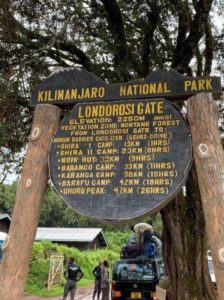 The day had finally come for us to climb Kilimanjaro. We definitely had butterflies in our stomachs and were nervous, but incredibly excited nonetheless. All our preparations had come down to this climb and we just needed to make sure we had everything packed and ready for the bus. Taking the Lemosho route, the drive was around 2 hours long from our accommodation in Moshi to Londorosi Gate (2250m). During this drive, we had already started making friends with the great group of people we were hiking with. Our bags then had to be weighed and arranged by the porters while all trekkers were officially being signed in. Afterwards, we enjoyed a nice boxed lunch before beginning our journey with a three hour hike up to Mti Mkubwa Camp (2650m). Making sure to keep it slow and steady, “Pole- Pole”, which means, “slowly, slowly” in Swahili was something we heard consistently throughout the hike from the porters. Being from sea level of about 200 feet, I could already feel the altitude and genuinely appreciated the reminder to pace myself.
The day had finally come for us to climb Kilimanjaro. We definitely had butterflies in our stomachs and were nervous, but incredibly excited nonetheless. All our preparations had come down to this climb and we just needed to make sure we had everything packed and ready for the bus. Taking the Lemosho route, the drive was around 2 hours long from our accommodation in Moshi to Londorosi Gate (2250m). During this drive, we had already started making friends with the great group of people we were hiking with. Our bags then had to be weighed and arranged by the porters while all trekkers were officially being signed in. Afterwards, we enjoyed a nice boxed lunch before beginning our journey with a three hour hike up to Mti Mkubwa Camp (2650m). Making sure to keep it slow and steady, “Pole- Pole”, which means, “slowly, slowly” in Swahili was something we heard consistently throughout the hike from the porters. Being from sea level of about 200 feet, I could already feel the altitude and genuinely appreciated the reminder to pace myself.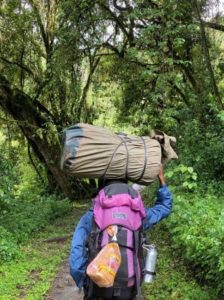
The hike up had a few steep sections, but was mostly level or gently sloping upwards in the rainforest where it’s possible to see Colobus and Blue
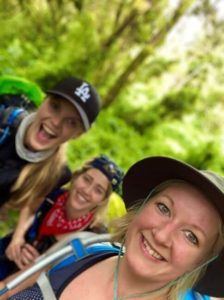
Velvet monkeys, tiny lizards, and beautiful native plant life. We reached our camp around 6PM, the first night being chilly and pouring down rain. We had been taking Diamox for the altitude and had to go to the bathroom frequently, but when the weather is that poor you’re not going to want to leave your tent. Luckily for us, we had purchased a pee cup unsure if we’d actually use it, but in the end were extremely grateful as it had saved us from many bathroom trips in the middle of the night. We woke up in the morning to the sun shining, packed our bags, ate breakfast, and began again.
Day 2: MtiMkubwa to Shira
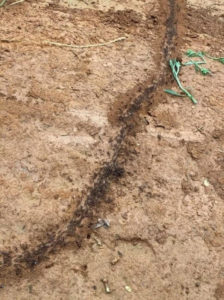 We continued hiking through more rainforest before reaching the Shira Plateau, one of the largest high altitude plateaus in the world. While in the rainforest, we stopped for a snack as well as a bathroom break. Helen had stepped away to go to the bathroom before racing
We continued hiking through more rainforest before reaching the Shira Plateau, one of the largest high altitude plateaus in the world. While in the rainforest, we stopped for a snack as well as a bathroom break. Helen had stepped away to go to the bathroom before racing

back, shaking her legs which were crawling with fire ants. The porters were quick to react, grabbing each and every one off of her. I tried holding back my laughter after knowing she was okay, but she knows me too well! Fortunately, the porters had responded swiftly otherwise our wonderful trip could have turned sour fast. We can look back and laugh at the moment now (probably me more than Helen lol), but it was definitely a comical yet scary experience. We also learned a lesson from that day and know to look out for the ant trails which are located all over the rainforest.
It’s about 4-5 hours of continuous uphill until you reach Shira I camp, but an hour before you arrive at Shira II camp, you’ll pass the “Garden of Senecio”. This area consists of uniquely shaped trees that resemble a desert form of palm trees. You’ll get to see more of these on Day 3, so be sure to get a picture with these eye-catching trees!
Day 3: Shira to Moir Hut
 Starting the day with an elevation of 3500m, we were going a distance of 14km, and it took
Starting the day with an elevation of 3500m, we were going a distance of 14km, and it took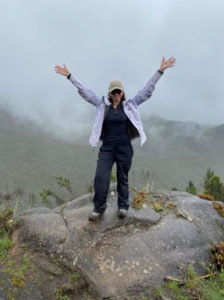 around 5-7 hours. This day was a bit of a rough day both mentally and physically for myself. It was downpouring, and we were all soaking wet, and I had learned my expensive, “waterproof”, gear was not actually waterproof. This included my jacket and backpack which were both advertised as such, and the trouble with this is that it rained steadily all day soaking me through. On a brighter note, the porters taught me how to dry my clothes in one night by wearing them to sleep under my sleeping bag! It was uncomfortable and frustrating initially, but now I can look back and think about how much I appreciate being about to push through, endure it, and learn something from it. It’s nice to be able to remember that moment and feel grateful for not only seemingly simple pleasures in our everyday lives (like dry clothes!), but experiences that teach us something new outside our comfort zone. That day, our guide, Ezekiel, asked me what I would have at home that was comforting and I told him ginger tea. Going forward, he had the cook make me fresh ginger tea every night! It was such a sweet and generous thing for him to do, and is just one of many examples of how the porters would go above and beyond to make our whole trip! As we continued and left the rainforest behind, the trail began to get steeper as it entered the moorland zone. A gentle grade walk takes you across the high altitude Shira caldera to Shira Cave with fabulous views of Arrow glacier. We camped there for the night at 4200m.
around 5-7 hours. This day was a bit of a rough day both mentally and physically for myself. It was downpouring, and we were all soaking wet, and I had learned my expensive, “waterproof”, gear was not actually waterproof. This included my jacket and backpack which were both advertised as such, and the trouble with this is that it rained steadily all day soaking me through. On a brighter note, the porters taught me how to dry my clothes in one night by wearing them to sleep under my sleeping bag! It was uncomfortable and frustrating initially, but now I can look back and think about how much I appreciate being about to push through, endure it, and learn something from it. It’s nice to be able to remember that moment and feel grateful for not only seemingly simple pleasures in our everyday lives (like dry clothes!), but experiences that teach us something new outside our comfort zone. That day, our guide, Ezekiel, asked me what I would have at home that was comforting and I told him ginger tea. Going forward, he had the cook make me fresh ginger tea every night! It was such a sweet and generous thing for him to do, and is just one of many examples of how the porters would go above and beyond to make our whole trip! As we continued and left the rainforest behind, the trail began to get steeper as it entered the moorland zone. A gentle grade walk takes you across the high altitude Shira caldera to Shira Cave with fabulous views of Arrow glacier. We camped there for the night at 4200m.
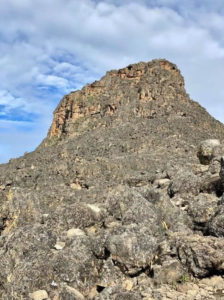
Day 4: Moir Hut to Lava Tower to Barranco Camp
Our fourth day began with another early start, but it’s a good acclimatization day, as we will, “climb high and sleep low”. It started with more uphill climbs (not as steep as the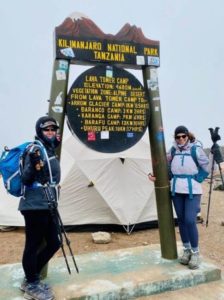 morning of day 2) into the alpine moorland region to the structure of Lava Tower. This is a large rock formation that can be climbed if trekkers choose to do so, however, this is pretty dangerous and you should consult with your guide before attempting it (this is because the high altitude of Lava Towers; its location is 4600m). Lava Tower is where the Lemosho, Machame, and the Umbwe routes combine continuing onto Barranco and Barafu camps, before approaching Uhuru Peak from Stella Point. You’ll have lunch at Lava Tower before going back downhill for about 90 minutes to reach Barranco Camp at 3900m. Upon arriving at Barranco Camp, you’ll see more beautiful Senecio trees. This is, perhaps, the most beautiful camp on the Lemosho Route unless the clouds coming up to Barafu Camp seems more impressive. Hopefully, you’ll reach camp around 3 PM. This offers a great opportunity to take some pictures of the Western Breach Wall. The camp is situated in a valley below the Breach and Great Barranco Wall.
morning of day 2) into the alpine moorland region to the structure of Lava Tower. This is a large rock formation that can be climbed if trekkers choose to do so, however, this is pretty dangerous and you should consult with your guide before attempting it (this is because the high altitude of Lava Towers; its location is 4600m). Lava Tower is where the Lemosho, Machame, and the Umbwe routes combine continuing onto Barranco and Barafu camps, before approaching Uhuru Peak from Stella Point. You’ll have lunch at Lava Tower before going back downhill for about 90 minutes to reach Barranco Camp at 3900m. Upon arriving at Barranco Camp, you’ll see more beautiful Senecio trees. This is, perhaps, the most beautiful camp on the Lemosho Route unless the clouds coming up to Barafu Camp seems more impressive. Hopefully, you’ll reach camp around 3 PM. This offers a great opportunity to take some pictures of the Western Breach Wall. The camp is situated in a valley below the Breach and Great Barranco Wall.
Day 5: Barranco Camp to Barafu Camp
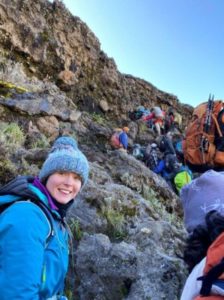
One of the most interesting parts of the Kilimanjaro climb took place as soon as we started hiking out of the Barranco Camp and sleeping for an extra hour. The Barranco Wall is famous for its narrow paths up the rock face while forcing you to navigate around other trekkers and porters on both sides.
We had to take it slow and steady, watching our footing. We came upon the famous Kissing Wall which is the part you have to jump across. Helen laughed as she said it was, “easy peasy lemon squeezy!”. We anticipated it was going to be much scarier based on YouTube videos, but not at all. Reaching the top of Barranco Wall, there is a nice plateau for a toilet break and scenic views. When we went, there was also a guy there in his Speedo doing a handstand posing for his above the clouds photo! He was definitely on cloud nine and made us all laugh. As we continued it took us about two hours, due to the crowds of climbers ascending the wall. After another five hours of up and down, we only ended up 100 meters higher than where we were to finish our day at Karanga Camp, 3995m. This additional acclimatization should hopefully help everyone adjust to the gradually higher altitude, as we push to the summit starting tomorrow night!
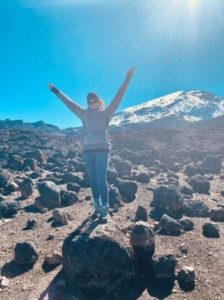
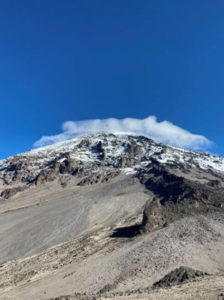
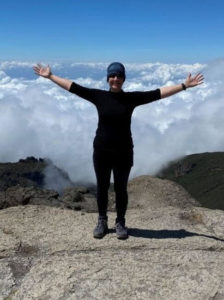
Day 6: Karanga Camp to Barafu Camp
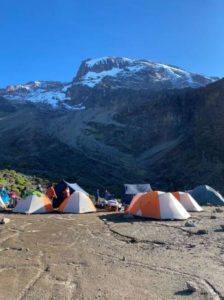 After sleeping in until 7AM again at Karanga Camp, you begin a 700m ascent in the alpine desert region to Barafu Camp, the official base camp for reaching the summit. This ascent only took us about three hours and then we had lunch in Barafu Camp at 4673m. Prior to the trip, I asked my daughter to make a video that I could watch, knowing at some point I would need some motivation or just want to hear a loved one’s voice. This day was the perfect moment to watch it. This small clip made everything complete and reminded me why I was there in the first place. It was very personal and had me tearing up.
After sleeping in until 7AM again at Karanga Camp, you begin a 700m ascent in the alpine desert region to Barafu Camp, the official base camp for reaching the summit. This ascent only took us about three hours and then we had lunch in Barafu Camp at 4673m. Prior to the trip, I asked my daughter to make a video that I could watch, knowing at some point I would need some motivation or just want to hear a loved one’s voice. This day was the perfect moment to watch it. This small clip made everything complete and reminded me why I was there in the first place. It was very personal and had me tearing up. 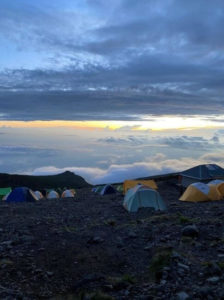 Just as I finished watching it she had sent another quick one right after which made me laugh: she said, “And remember to kick that mountain’s a**! Make it your b***h!”. What great inspiration! I was nervous but ready at the same time. We had tried to sleep for about 3-4 hours before an early dinner at 5pm. This was the infamous summit day that we had been waiting for (dreading and fearing as well), but the time had arrived. After dinner, our guides asked us to go back to bed and wake up again at 11 PM for a strict 12 AM push out of Barafu Camp to start climbing towards the summit.
Just as I finished watching it she had sent another quick one right after which made me laugh: she said, “And remember to kick that mountain’s a**! Make it your b***h!”. What great inspiration! I was nervous but ready at the same time. We had tried to sleep for about 3-4 hours before an early dinner at 5pm. This was the infamous summit day that we had been waiting for (dreading and fearing as well), but the time had arrived. After dinner, our guides asked us to go back to bed and wake up again at 11 PM for a strict 12 AM push out of Barafu Camp to start climbing towards the summit.
Day 7: Barafu to Summit to Barafu to Mweka Hut Camp
This is by far the most challenging day of the trek and may rank as your most challenging climbing day ever! This is due to the fact that it actually begins before midnight and will continue for more than 16 hours before you make it to your final campsite for the night. Most trekking groups summiting on the Lemosho route will wake groups at about 11PM with the intention of leaving right around midnight for potentially reaching the summit by sunrise. It is recommended to get up even earlier (say around 10:30 PM) in order to have enough time to get all the warm layers on and supplies that you will need for the 6+ hour continuous uphill push to the summit. Make sure that your headlight has fresh batteries – my headlamp barely made it to the top before it died (the cold makes the batteries run out faster) and you have packed adequate snacks and energy gels for the journey. Then after a quick round of tea and biscuitsthat the guides so generously have waiting for the trekkers at Stella Point, it will be time to push on to the summit!
The summit climb to Stella Point at the top of the continuous uphill sectionconsists of what seems like a never–ending series of switchbacks in the dark with occasional rock faces that must be scrambled up and over. Unless everyone on your team is facing no health issues between Barafu Camp at 4673m and the 1000m+ climb to Stella Point at 5756 m, the sun will likely rise before reaching Uhuru Peak if your team doesn’t leave until 12AM. However, the warm sun coming up is a welcome respite from the bitter cold. There may also be traffic jams along the way up with the other trekkers from the Machame and Umbwe routes, who reach the summit via Stella Point, which is where climbers finally reach the top of the peak and the end of the switchbacks.
What is deceiving, however, is that Stella Point is not the end of the journey. Although the route does get considerably flatter from Stella Point, there is still a full kilometer to go, which can take upwards of one hour for those feeling every bit of the 5,700+ m. Be careful to stick to the trail and enjoy the views of the glaciers from the top as you head to the famous green sign with yellow writing. This replaced the old sign in 2012, but it’s where everyone will be waiting for their chance to get the iconic Kilimanjaro summit photo. Just keep everything “pole-pole” (slowly slowly) and the reward will be well worth it as you reach Uhuru at 5985m!
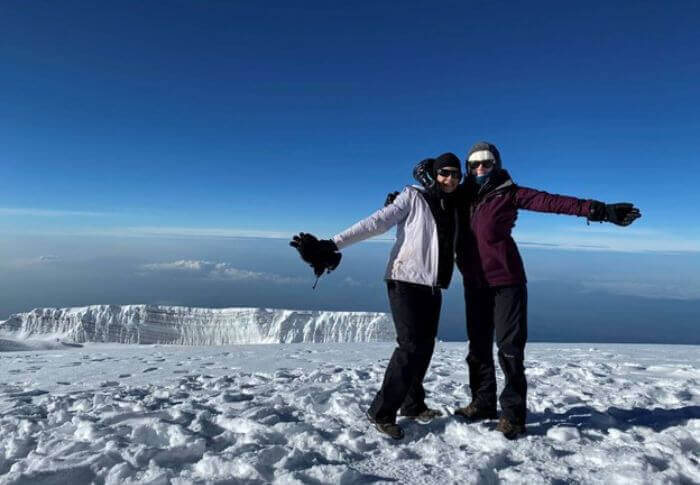
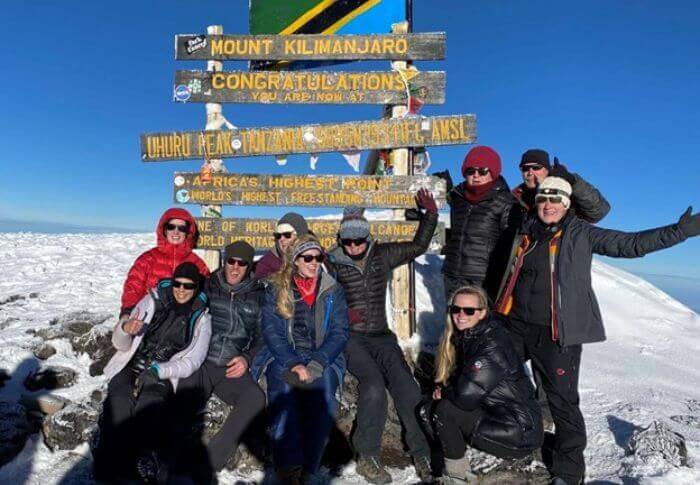
As soon as you are satisfied with your pictures, it is best to go back down as soon as possible, and the faster that you descend, the quicker your high altitude symptoms will disappear. The road down is, unfortunately, exactly the way that you came up, and can prove very challenging to trekkers not comfortable with constant downhill. There is a lot of volcanic scree in this section, hot dust flying into the air, and climbers sliding down the mountain navigating the switchbacks while trying to stay on their feet. Barafu Camp is easily visible from the outset of the downhill, but it can feel like forever away for a few hours.
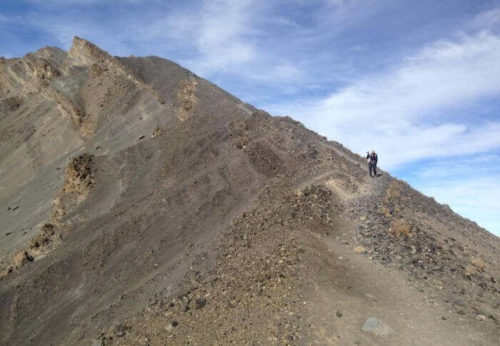
Expect to spend about 3-4 hours making your way back to Barafu for a 1-2 hour nap in camp before lunch and then packing everything up to head back down to Mweka Hut Camp. It may seem like a real struggle to pack everything up after napping and pushing yourself to keep going further down the mountain, but sleeping at 3100m at Mweka Hut Camp will be much easier than 4673m at Barafu Camp. It should take another 3-4 hours to get down to Mweka Hut Camp on relatively easy downhill sections consisting of mostly wide dirt roads used as the main thoroughfares for porters carrying things back down the mountain. Mweka Hut Camp is lush and green compared to the alpine desert where you’ve spent your last couple of days and is one of the most beautiful camps on Kilimanjaro. We enjoyed our final night on the mountain!
Day 8:
If you made it to Mweka Hut Camp the night before, the walk back down to Mweka Gate, (and the official end for theLemosho and Machame routes) is laid back and beautiful, taking less than 3 hours and finishing in the rainforest at a very comfortable 1640m. Enjoy the thick air and lush green of your surroundings as you reflect back on your special time in this unique place in the world. There is a real spirit of celebration at Mweka Gate as teams complete their final sign out and your guides pick up official Mt. Kilimanjaro hiking certificates. We made a brief stop at a large souvenir shop just near the Mweka Gate that does take credit cards and you will later pass robust coffee farms on both sides as you ride 30 minutes back to Moshi to retrieve the rest of your luggage and check back into your hotel.
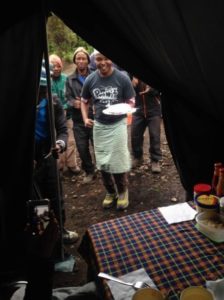
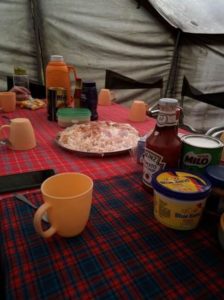
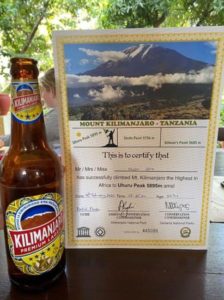
At around 6 PM on our final evening, we met with the guides as they handed out climbing certificates and we all savored a beer to celebrate. Afterward we all met to have dinner and reflect back on a job well done on the Lemosho route! So proud of everyone and our accomplishment!!




